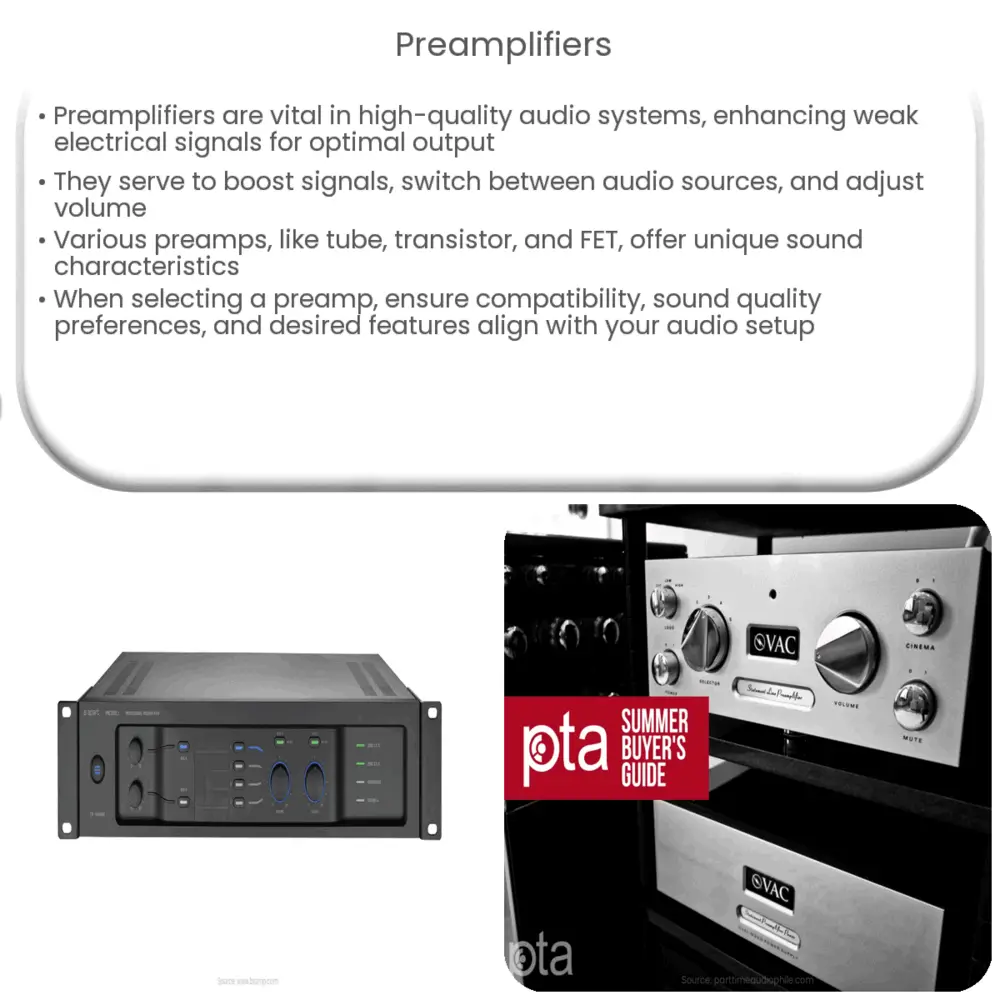Explore the role and types of preamplifiers in audio systems, their impact on different audio sources, and tips for choosing the right preamp.

The Importance of Preamplifiers in Audio Systems
When it comes to high-quality audio, one device often overlooked but immensely significant is the preamplifier. By definition, a preamplifier (preamp for short) is an electronic amplifier that converts weak electrical signals into an output signal strong enough to be noise-tolerant and suitable for further processing or for sending to a power line level.
Primarily, preamplifiers serve three main roles in an audio system. First, they boost signals from your source equipment, such as a turntable or digital audio player, to a level that your power amplifier can work with effectively. Second, they provide a way to switch between different source components. Lastly, they offer a means to adjust the volume of the audio signal.
The Role of Preamplifiers in Different Audio Sources
In different audio sources, the role of preamplifiers varies and can be fundamental. For instance:
- Turntables: Phonograph signals are typically very weak and require a more specialized preamplifier known as a phono preamplifier or phono stage. This device not only boosts the signal but also applies the correct equalization curve to match the recording characteristics.
- Microphones: In professional audio systems, microphones often send their signals to a dedicated microphone preamp that’s usually built into audio interfaces or standalone rack units.
- Digital Audio Players: While most modern audio players have built-in preamps, some high-end models allow for an external preamp, ensuring greater control and flexibility over the audio signal.
Types of Preamplifiers
Preamplifiers come in various forms, each with its unique features and specifications. Here are some common types:
- Tube Preamps: Known for their warm, smooth sound, tube preamps utilize vacuum tubes to amplify the signal. They are often favored by audiophiles for their unique sonic characteristics.
- Transistor Preamps: These are the most common types of preamps, utilizing semiconductors rather than tubes. They are generally more reliable, durable, and require less maintenance than tube preamps.
- FET Preamps: Field-effect transistor (FET) preamps are prized for their impedance characteristics and can emulate tube preamps’ warmth to a certain degree.
Each type of preamplifier serves a distinct purpose and brings a unique sound to the table, depending on the specific components used in their design and construction.
Choosing the Right Preamplifier
When choosing a preamplifier, several factors need to be considered. These include the type of source equipment you’re using, the kind of power amplifier you’re connecting to, and the sound character you prefer.
- Compatibility: Ensuring your preamp is compatible with your source equipment and power amp is critical. For instance, if you’re using a turntable, a preamp with a dedicated phono stage would be beneficial.
- Sound Quality: Different preamps produce different sound qualities. Tube preamps, for example, are known for their warm sound, while transistor preamps provide a more precise, detailed audio.
- Features: Some preamps come with additional features like tone control, balance adjustment, and even digital inputs for versatility. If these features matter to you, look for a preamp that offers them.
Remember, a high-quality preamp can significantly improve your audio experience, but it’s essential to balance it with the rest of your equipment for the best results.
Conclusion
In conclusion, preamplifiers play an essential role in high-quality audio systems. They boost and refine the signal from source equipment, facilitate source switching, and provide volume control. There are different types of preamplifiers, including tube, transistor, and FET preamps, each offering unique sound characteristics and benefits.
When choosing a preamplifier, compatibility with your other audio equipment, desired sound quality, and additional features are crucial factors to consider. Therefore, understanding the role and types of preamplifiers can significantly enhance your audio experience, ensuring you get the most from your music and audio systems.

